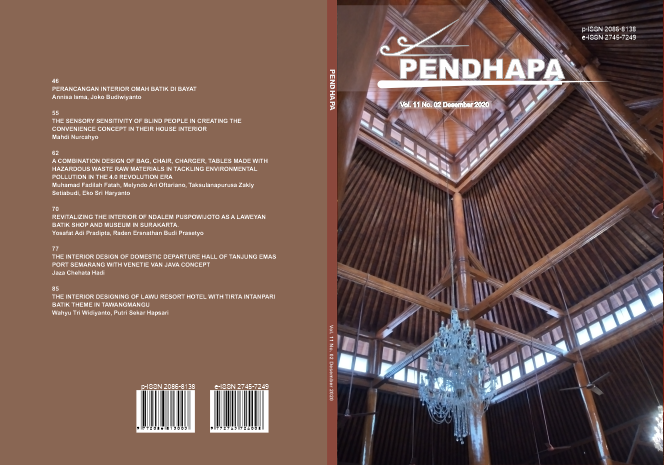The Sensory Sensitivity of Blind People in Creating the Convenience Concept in their House Interior
DOI:
https://doi.org/10.33153/pendhapa.v11i2.3616Keywords:
blind people, aesthetic, sense of experience, regularityAbstract
This study aims to examine how a blind person recognizes and presents the aspects of convenience inside the house. The limited ability to see does not make the blind people weak, but it becomes an advantage and an easy walk when carrying out daily activities at home. The experience of the body and senses of the occupied space opens the blind people's awareness to be able to create a "feeling of home" as part of ways of giving the meaning of life for their days. Through a sense of experience, blind people have the ability to organize spaces including scale, shape, material, and distance according to their body's convenience. The sensory sensitivity of blind people in creating a sense of convenience is one of the parts of the process of forming the orderliness of the space they inhabit.
Downloads
References
Ibrahim. 2014. “Wawancara Dengan Desainer Jaya Ibrahim.” Jakarta.
Leach, Neil. 1997. Rethinking Architecture. New York & London: Routledge.
Rapoport, Amos. 1982. The Meaning of the Built Environment. Arizona: The University of Arizona Press.
Simatupang, Lono Lastoro. 2013. Pagelaran: Sebuah Mozaik Penelitian Seni-Budaya. Yogyakarta: Jalasutra.
Downloads
Published
Issue
Section
License
Authors who publish with Pendhapa agree to the following terms:
- Authors retain copyright and grant the journal right of first publication with the work simultaneously licensed under a Creative Commons Attribution License (CC BY-SA 4.0) that allows others to share the work with an acknowledgment of the work's authorship and initial publication in this journal.
- Authors are able to enter into separate, additional contractual arrangements for the non-exclusive distribution of the journal's published version of the work (e.g., post it to an institutional repository or publish it in a book), with an acknowledgment of its initial publication in this journal.
- Authors are permitted and encouraged to post their work online (e.g., in institutional repositories or on their website) prior to and during the submission process, as it can lead to productive exchanges, as well as earlier and greater citation of published work.

This work is licensed under a Creative Commons Attribution-ShareAlike 4.0 International License.









